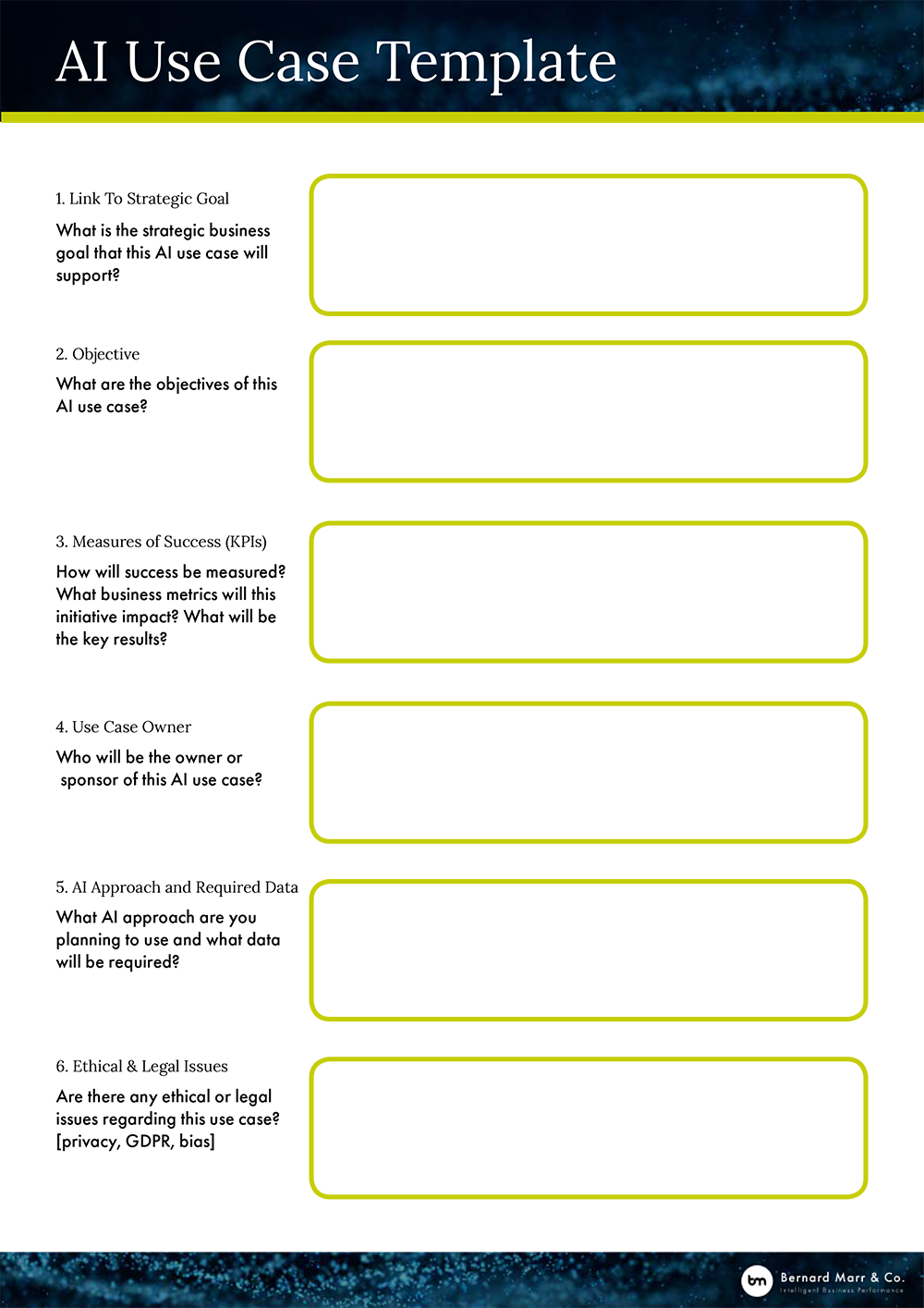How To Define Your AI (Artificial Intelligence) Use Cases – With Handy Template
2 July 2021
An AI strategy is essential for making sure your business uses AI in a strategic way – a way that’s directly linked to your company’s goals. Developing an AI strategy means identifying how your business can best use AI. These are also known as your AI priorities or use cases.
div
When I work with organisations to create their AI strategy, we usually identify between three and five AI use cases – sticking to a small number like this ensures your AI strategy remains focused and achievable.
Because your AI use cases will be driven by your business strategy, every company will have its own unique set of use cases. An AI priority for one company may not be relevant to another. However, some common examples of AI use cases include:
- Developing smarter products
- Developing smarter services
- Making business processes more intelligent
- Automating repetitive or mundane tasks
- Automating manufacturing processes
Whatever your AI use cases, this article – and the accompanying AI Use Case Template – is designed to help you flesh out your use cases, define your AI priorities in more detail, and work towards a comprehensive, thoughtful AI strategy. You might want to have the AI Use Case Template open as you read this article.
Within the template, you’ll see there are 10 sections to complete. Fill in a separate template for each of your use cases.
- Link to strategic goal
It’s vital AI is used in a strategic way, so this first section gets you to link your AI priority to a strategic business goal. AI can mean big changes for a business, and these changes can sometimes be disruptive, expensive and time consuming. It’s therefore helpful to pinpoint exactly why you’re doing what you’re doing, and how AI will help the business achieve its objectives, grow and prosper.
- Objective
In this section, define your AI-related goal in more detail. For example, perhaps there are key business questions that AI can help you answer, or business-critical problems that AI can help you solve. What are you ultimately hoping to achieve with AI?
- Measures of success (KPIs)
Here, you ask yourself the question ‘what does success look like for this AI project, and how will we measure success?’ Be specific, and identify which business metrics/KPIs you’ll use to track progress.
- Use case owner
Who in the business is responsible for this AI use case? In my experience, if you don’t make someone accountable, it may never get done! Naturally, the use case owner will have to enlist others to help deliver the project, and that’s fine. The important thing is that one single person has overall responsibility and ownership of the project.
- AI approach and required data
AI encompasses a number of subdivisions, most notably machine learning and deep learning. So which AI approach will you use to achieve your AI goal, and what sort of data do you need? Refer back to your data strategy at this point, as it may be impacted by your AI needs.
- Ethical and legal issues
Ethics is a huge issue in AI right now as, by its very nature, the idea of AI and intelligent machines tends to make people nervous. So, as well as considering the legal implications of your AI use case (don’t forget consent and data privacy here, especially GDPR), think carefully about the ethical implications of what you’re doing. How can you ensure your AI use case makes a positive contribution to the business, its employees and its customers?
- Technology and infrastructure
It’s very likely your AI use case will require certain technology and infrastructure changes. Therefore, in this section you set out the technology-related implications, challenges and requirements. In other words, what systems, software and hardware do you need to invest in?
- Skills and capacity
AI brings with it very particular challenges around skills, capabilities, capacity and resourcing, especially for smaller and mid-sized companies who don’t have an army of data scientists in house. Consider any skills gaps that might prevent you from achieving your AI goal, and how you’ll close those gaps. For example, can you train staff, hire new talent, or partner with an external AI provider?
- Implementation
Here you set out the potential implementation challenges and roadblocks that you’ll need to overcome if your AI goal is to become reality.
- Change management
Change management is often included in with implementation (above), but because AI can represent big changes in how the company operates, it’s really important to manage that change carefully. In particular, if you’re automating or streamlining processes, this may have an impact on the work that employees do. How will you manage this change, while promoting a positive culture of AI in the business?
Where to go from here
Repeat this process and complete the same template for each of the AI use cases that you’ve identified. This will help you evaluate and prioritise your use cases in order of strategic importance.
Having done that, you can then start to identify the common themes, issues and requirements across your AI use cases and plan your strategy. I have a template to help you with that, too – check out my related article ‘An AI Strategy Template that Any Company Can Use’.
You may also be interested in reading about:
Related Articles
A Beginner’s Guide To Building AI Agents
By now, “smart” versions exist of just about every home appliance, gadget and gizmos we can think of. However, manufacturers continue[...]
5 Business Trends Every Company Must Prepare for in 2026
By now, “smart” versions exist of just about every home appliance, gadget and gizmos we can think of. However, manufacturers continue[...]
The Quantum Revolution Is Here, And It’s About More Than Just Computing
By now, “smart” versions exist of just about every home appliance, gadget and gizmos we can think of. However, manufacturers continue[...]
AI Browser Agents Radically Transform How We Use The Internet
By now, “smart” versions exist of just about every home appliance, gadget and gizmos we can think of. However, manufacturers continue[...]
The 6 Defining Manufacturing Trends Of 2026
By now, “smart” versions exist of just about every home appliance, gadget and gizmos we can think of. However, manufacturers continue[...]
Enterprise AI Meets The Digital Labor Economy: My Highlights From Workday Rising EMEA
By now, “smart” versions exist of just about every home appliance, gadget and gizmos we can think of. However, manufacturers continue[...]
Sign up to Stay in Touch!
Bernard Marr is a world-renowned futurist, influencer and thought leader in the fields of business and technology, with a passion for using technology for the good of humanity.
He is a best-selling author of over 20 books, writes a regular column for Forbes and advises and coaches many of the world’s best-known organisations.
He has a combined following of 4 million people across his social media channels and newsletters and was ranked by LinkedIn as one of the top 5 business influencers in the world.
Bernard’s latest book is ‘Generative AI in Practice’.












Social Media